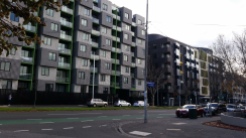On Fridays, I usually volunteer down at Brotherhood Books in Kensington. I catch the train to the very sparse Kensington South station and walk along Childers St./Hobsons Rd, crossing Kensington Road. But as I left the station last Friday, a passerby warned me that I wouldn’t be able to cross Kensington Road. He was right. I looked up Hobsons Rd and thought “no-one’s going to be working there today”. And I was right. Brotherhood Books has been closed all week, after the Maribrynong river washed through our warehouse. (If you click on the images, you can see a larger version).


So, I had the rare experience (for this year) of a free Friday. It felt like a holiday! We decided to go in to see the ‘Lust Love Loss’ exhibition at the Shrine of Remembrance, then to pop in to the NGV International.
I haven’t been to the Shrine for probably 30 years. Its new galleries underneath the hill on which the Shrine is placed and the unobtrusive entrance received well-deserved architectural acclaim. The Shrine is such a strange place: built to last for hundreds of years in stone and marble, with lots of Egyptian references combined with classical figures and marble reliefs of battles (which reminds me that I really must read Ken Inglis’ Sacred Places one day).




I was impressed with the three exhibitions: Lust Love Loss (which closes 20 November 2022), Defending with Pride, the first of its kind for an Australian war memorial (closes July 2023) and For Kin and Country (until 26 March 2023) the history of First Peoples’ service in the Australian Defence Force, a display which makes you feel angry and ashamed of the discriminatory treatment that they received on returning home.
I really liked the human scale of these exhibitions, with none of the big-boys-toys approach being pushed by Brendan Nelson at the Australian War Memorial. But I am mystified that with all the ‘professionalism’ of the GLAM sector, so many signs were difficult/impossible to read. Why would you put black print on a dark khaki background in a dimly lit gallery? I don’t want to go through a gallery with the catalogue on my phone, drawing my eyes constantly to a 15 cm screen that pings messages at me: I want to look at the exhibition. The artworks and photographs had only rudimentary signage beside them on the walls, and there were only two printed catalogues available (which we returned for someone else to use).
Then off to the NGV International. When was Deborah Halpern’s Angel sculpture moved out of the moat? (Ooops! 2006. Why hadn’t I noticed earlier?) I was keen to see Richard Mosse’s Broken Spectre but it was so loud and dark – and the chairs at the back were taken and it was too dark to see if there were any other chairs there, and no way was I going to sit on the floor in the dark for 74 minutes…..and yes, I’m sounding like a grumpy old lady. So we went up to the Jewellery and Body Adornment display on the balcony which was interesting, although again with rather baffling signage. I liked the malicious glee of the Gold Makes Blind, Bracelet (the middle bracelet). Covered in rubber, there is (supposedly) a gold bracelet underneath the rubber, but you need to destroy the bracelet to see if it is really there.



I liked the pieces that had some social history attached to them. I had heard of Josiah Wedgwood’s Anti-Slavery medallion, but never seen one. I was rather taken with Sylvia Pankhurst’s Holloway Brooch (in the middle in the image below) which was awarded to women who had been imprisoned. The two medals with the green, white and purple ribbons were awarded by the Women’s Social and Political Union to women who had endured hunger strikes while in prison. Fewer than 100 of these medals were awarded.


Off to lunch at Roule Galette in Flinders Lane- and yes, the city still is much quieter than it used to be- then back home for a grand-daughter pick up from school. I haven’t ever done the pick-up run because I’m usually down at the Brotherhood- and hopefully, things will have dried out enough that I can be down there again next Friday. Says she, with thunder rumbling outside.






























